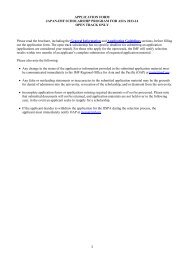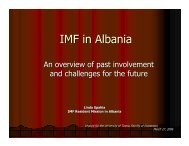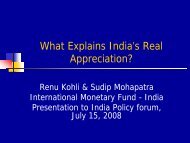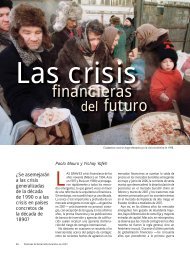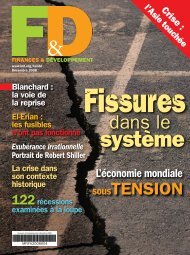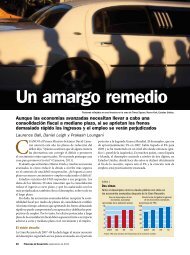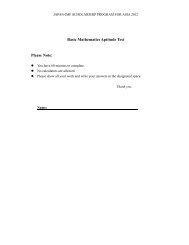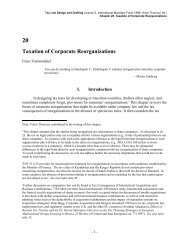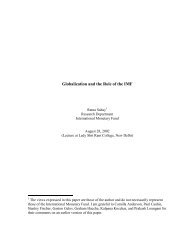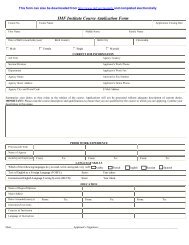Overview of Capital Account Crisis - IMF
Overview of Capital Account Crisis - IMF
Overview of Capital Account Crisis - IMF
Create successful ePaper yourself
Turn your PDF publications into a flip-book with our unique Google optimized e-Paper software.
- 7 -<br />
be made liquid, there remained a potential financing gap <strong>of</strong> US$21 billion if short-term<br />
liabilities could not be rolled over.<br />
• Of the non-bank sector’s total liabilities, some US$66.4 billion was owed to foreigners in<br />
foreign currency (including equity, which would likely be converted into foreign<br />
currency if foreigners withdrew), <strong>of</strong> which US$23.6 billion was short-term.<br />
• Commercial banks were covering their overall (short- and long-term) FX-denominated<br />
liabilities <strong>of</strong> US$48.1 billion 6 with foreign assets <strong>of</strong> US$7.0 billion and FX-denominated<br />
claims on domestic residents <strong>of</strong> US$31.5 billion, leaving a net FX liability position <strong>of</strong><br />
US$9.6 billion. However, this assumed that domestic residents would be able to cover the<br />
US$31.5 billion <strong>of</strong> FX-liabilities in the event <strong>of</strong> a devaluation. The non-financial sector’s<br />
foreign liabilities amounted to US$98 billion (against foreign asset holdings <strong>of</strong> just<br />
US$0.5 billion). Thus, to the extent that the non-financial sector did not have a natural<br />
FX hedge (i.e., were not exporters), the US$31.5 billion <strong>of</strong> FX-risk <strong>of</strong> the banking system<br />
had simply been transformed into credit risk. 7 Compounding this risk was the weak<br />
capital structure <strong>of</strong> the corporate sector in Thailand (and in Asia, more generally), with an<br />
average debt-equity ratio <strong>of</strong> 196.<br />
These mismatches meant that Thailand’s vulnerability to a crisis was far greater than the<br />
US$10 billion aggregate short-term liability position to the rest <strong>of</strong> the world would suggest.<br />
<strong>Crisis</strong> Trigger<br />
12. In the event, the proximate trigger <strong>of</strong> the crisis was the asset price deflation (stock<br />
prices fell by 60 percent between mid-1996 and mid-1997, while inflation-adjusted property<br />
prices fell by 50 percent between end-1991 and end-1997). This called into question the<br />
creditworthiness <strong>of</strong> the non-financial sector and therefore the quality <strong>of</strong> banks’ assets,<br />
including its FX cover. Against a background <strong>of</strong> an unsustainable current account deficit<br />
(which had reached 8 percent <strong>of</strong> GDP in 1996), a significant real exchange rate appreciation,<br />
and a weakening fiscal balance, pressures on the Thai baht increased during 1996 and the<br />
first half <strong>of</strong> 1997. Of the US$38 billion <strong>of</strong> foreign exchange reserves at end-1996, the Bank<br />
<strong>of</strong> Thailand used up some US$7 billion in foreign exchange intervention plus increasing its<br />
FX forward and swap obligations from about US$5 billion to almost US$30 billion.<br />
Information on the counterparties to these <strong>of</strong>f-balance sheet swap operations is not available.<br />
To the extent that these were Thai banks, this would have decreased the (on-balance sheet)<br />
FX exposure <strong>of</strong> the banking system without implying a loss for the country as a whole. But if<br />
they were nonresident entities, this would have meant that the country had only US$3 billion<br />
6 This assumes that all medium-term liabilities to the external sector were denominated in<br />
foreign currency.<br />
7 Writing <strong>of</strong>f the claims <strong>of</strong> the banking sector on the non-financial sector would, obviously,<br />
worsen the balance sheet <strong>of</strong> the former, to US$41 billion.





